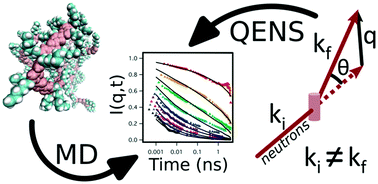Assessment of molecular dynamics simulations for amorphous poly(3-hexylthiophene) using neutron and X-ray scattering experiments†
Abstract
The molecular morphology and dynamics of conjugated polymers in the bulk solid state play a significant role in determining macroscopic charge transport properties. To understand this relationship, molecular dynamics (MD) simulations and quantum mechanical calculations are used to evaluate local electronic properties. In this work, we investigate the importance of system and simulation parameters, such as force fields and equilibration methods, when simulating amorphous poly(3-hexylthiophene) (P3HT), a model semiconducting polymer. An assessment of MD simulations for five different published P3HT force fields is made by comparing results to experimental wide-angle X-ray scattering (WAXS) and to a broad range of quasi-elastic neutron scattering (QENS) data. Moreover, an in silico analysis of force field parameters reveals that atomic partial charges and torsion potentials along the backbone and side chains have the greatest impact on structure and dynamics related to charge transport mechanisms in P3HT.



 Please wait while we load your content...
Please wait while we load your content...